SCOTLAND A POTTED HISTORY |
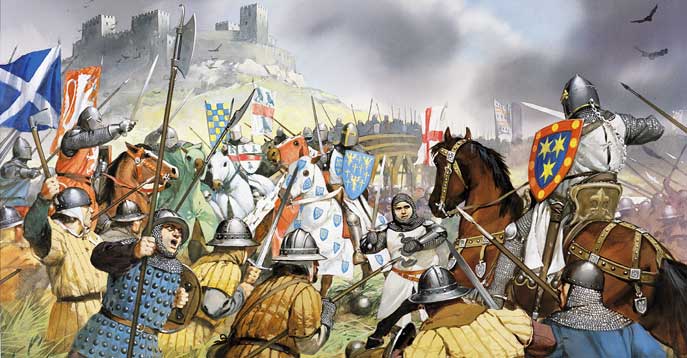 |
The accession of the girl-queen, Margaret of Norway, put Scottish political stability to a severe test, but the work of David I and Alexander III proved equal to that test. |
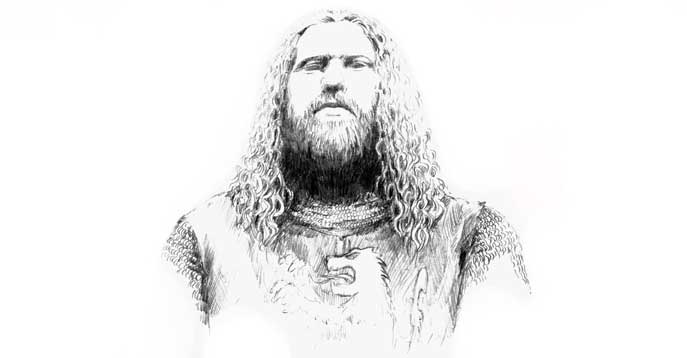 |
The various claimants with greedy haste, and the other political leaders rather more slowly, accepted his demands and the process of selection began. He had thirteen major claimants to consider, but ten of them, for various reasons, were quickly and easily disposed of, and his choice was to lie with one or other of the three claimants descended from David, Earl of Huntingdon, the youngest son of David I. Earl David had three daughters, all of whom had male descendants. The question was, should the descendants of the eldest daughter take precedence over the descendants of her younger sisters? Today, the answer would be 'yes' but in 1291-92 there was not the same acceptance of the idea that any precedence existed among daughters. There was the added complication that the descendant of the eldest daughter was Earl David's great-grandson, while the descendant of the second daughter was his grandson, and therefore closer in blood to the common ancestor. After much examination of precedents elsewhere in the feudal world it was decided that seniority was to be preferred to 'nearness in blood', and the Scottish crown was therefore awarded to Earl David's great-grandson, John Balliol, to the keen disappointment of Earl David's grandson, Robert Bruce, who had once, in the days of Alexander II, been designated heir, but who now, in old age, saw all ambition ended. John Balliol's accession was marred by the bullying approach employed by Edward, and his early experience as King of Scots was rendered unhappy by further bullying. Anxious, no doubt, to make his point clear, Edward required various displays of obedience from Balliol, for whom humiliation at Edward's hands seemed likely to become a way of life. But even such a shrewd man as Edward was capable of misjudgement, and even Balliol could be provoked beyond endurance. That provocation came when, in 1295, Edward was about to mount an expedition against France and ordered Balliol, as his feudal inferior, to join him in the war which was about to commence. The worm now turned. Balliol, known to his derisive subjects as 'Toom Tabard' - 'empty coat' or 'stuffed shirt' - had some pride, and some awareness that nothing but exploitation and humiliation faced him in the future. Accordingly, instead of obeying, he renounced his allegiance to Edward, and instead entered into an alliance with France, whereby the two countries agreed to take joint military action against England whenever the latter attacked either of them. This Franco-Scottish alliance - the Auld Alliance - was to be the basis of Scottish foreign policy for almost 300 years. Edward's punishment of Balliol's defiance was swift and savage. In 1296 English forces invaded Scotland. Berwick was besieged, stormed and destroyed, its people massacred and its prosperity gone for ever. Balliol's army was shattered in battle at Dunbar, and by the late summer his reign was over. On 2 July he surrendered to Edward 'the land of Scotland and all its people', and he made his own personal and symbolic act of submission, barefoot, half-naked and unarmed, in the church of Stracathro. Well pleased with himself, Edward had a brisk look around his new property, and returned home. There was to be no new puppet king. Robert Bruce ventured to suggest that this might be his hour, drawing from Edward the contemptuous response that he had better things to do than go round conquering kingdoms for Bruce. Instead he placed control of Scotland in the hands of English officials; John de Warenne, Earl of Surrey, was military commander, and Hugh de Cressingham, churchman and bureaucrat, was responsible for civil administration. The absorption of Scotland into Edward's Greater England, seemed now inevitable, and even the records of government and the symbols of nationhood were removed to England, the fragment of the True Cross from Holyrood and the Stone of Destiny from Scone. As for resistance, none was to be anticipated, as the landowners of Scotland hurriedly and tactfully rushed to place their names on a list of those doing homage to Edward - a list which later generations were to know, derisively, as 'the Ragman's Roll'. And yet resistance there was - a heroic episode which became the great national myth or folk-memory of Scotland. Some guerrilla activity was undertaken by Sir William Douglas in the south and by Andrew de Moray in the north, but most famous and honoured of all these resistance leaders was William Wallace. Countless words have been written about Wallace, most of them based upon the epic poem The Wallace, written by Henry the Minstrel or 'Blind Harry', some two centuries after the events which he describes. Yet Harry's narrative, where it can be checked against the references to Wallace which are to be found in the chronicles of his time, stands up to scrutiny rather well. The probability must be that Harry was working from an oral tradition, which must indicate that Wallace was a subject of hero-worship and legend for many generations before Harry wrote his poem. |
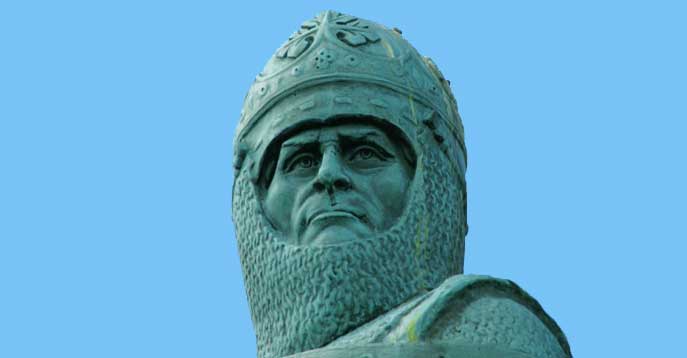 |
The story is now widely familiar and widely available. Its hero is the younger son of a knight who held lands as a tenant of the Stewards at Elderslie in Renfrewshire. Born around 1270 he was approaching manhood as the disasters following Alexander's death were occurring. Taught by an uncle, a priest at Dunipace, to cherish the idea of freedom, his education was carried forward at the church school in Dundee. His presence in the east of the country is accounted for by the tradition that his father had become politically unpopular through his active opposition to the growing English domination which followed the Treaty of Birgham, and the young Wallace with his mother, moved discreetly to live with relatives in the Carse of Gowrie. In Dundee an adolescent dispute ended with Wallace killing the son of the commander of Dundee's English garrison, for which deed he became - and, in English eyes, remained - an outlaw. He was capable of taking vengeance for others as well. When the English governor of Ayr invited local Scottish leaders to meet him and then had them all hanged as they arrived, Wallace responded by taking his men into Ayr, securing the doors of the buildings where English soldiers lay, and setting fire to them. There is a local tradition that the Scots watched Ayr burn from a hilltop near Tarbolton a few miles from the stricken town. |
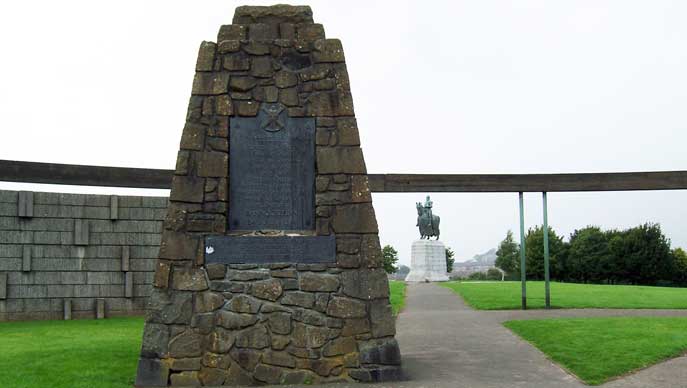 |
| But his modest social status did present problems. It would never be easy for the nobility to endure leadership even of a proven patriot and warrior indefinitely. Some were jealous no doubt; most had played no part whatever in the national struggle, and some who had, like the young Robert Bruce of Annandale and Carrick, could not be expected to follow the lead of a leader who acted in the name of John Balliol. The probability had to be that Wallace's tenure of power and influence would be purely temporary. He made what use he could of his time as Guardian, seeking to restore normality in trade and diplomacy, trying to persuade the rulers of Europe to accept that Scotland was once more a free participant in world affairs. Most were perfectly civil, and may even have been sympathetic, but all would know that Edward was not the man to let matters rest. In 1298 Edward led his army - enormous by the standards of the time - into Scotland to punish this bandit, this terrorist, who had so defied and humiliated him. Against such power as Edward's, no Scottish force could reasonably hope for success in battle. The best hope, then and always, for the Scots, lay in retreat and delay; avoiding pitched battles, keeping an armed force in existence, while the English were drawn further from their bases into remoter parts until winter approached, supplies ran short and retreat became necessary. Wallace appears to have intended to follow such a strategy, but Edward was able to keep up such a hot pursuit that the Scottish army found itself forced to turn and fight at Falkirk. Even then there was still hope. The Scottish schiltrons - densely assembled circles of spearmen - could be relied upon to beat back as many cavalry charges as an enemy cared to make, but unfortunately for the Scots Edward had a new military tactic at his disposal. Before he had found the opportunity to seize control of Scotland he had already conquered Wales, and his army at Falkirk had a large force of Welsh archers. These bowmen were able to inflict heavy losses upon the schiltrons from a safe distance, tearing gaps in the Scottish ranks through which English cavalry could in due course charge. The way to deal with archers was to send cavalry against them, and this Wallace tried to do. But cavalry - armoured knights - were drawn from the ranks of the nobility and the gentry, who alone could afford horses and armour. Here at last Wallace's lack of aristocratic support proved crucial. The small cavalry force which he did have, saw itself overmatched, considered the likely outcome of the battle, and ran away. The Scottish formation was gradually broken down, and was soon retreating into the safety of the Torwood, which Wallace had perhaps seen as a refuge if things went badly. With his defeat, his power was gone. He resigned his position as Guardian, being replaced by the leaders of the two main political factions in Scotland - John Comyn and Robert Bruce, together with Bishop Lamberton of St. Andrews. Wallace continued, it seems, to conduct some guerrilla operations, which were still possible, because he had come so near to success. Only a few weeks after his victory, Edward had had to lead his hungry army back home, leaving Scotland far from properly under control. Also, Wallace seems to have gone on diplomatic missions seeking moral support in Norway, in France and, perhaps, in Rome. It is said that Edward tried to win Wallace over, offering perhaps even the crown itself, if only he would agree to hold it as Edward's subordinate. No temptations worked; Wallace remained irreconcilable, and English pride and security alike required his destruction. Comyn and Bruce, and various lesser persons, were all at one time or another bidden by Edward to secure and hand over Wallace to him. How hard they tried, we do not know, but for a man hunted as Wallace now was, there must always be the danger of betrayal. On 5 August 1305, Wallace and two followers settled for the night in the house of Ralph Rae at Robroyston. During the night, we are told, one of Wallace's companions, a relative of Sir John Stewart of Menteith (who in his time had held Dumbarton Castle for both the Scots and the English), betrayed Wallace and opened the door to Menteith's men. Their story at firstwas that, in the interests of peace, Wallace was to go to be in Menteith's charge at Dumbarton, but once subdued, he was instead handed over to an English escort, and hurried to London. Menteith's reward was £151. On 23 August in Westminster Hall, Edward at last confronted this man who had refused all attempts to win him over, or to make him abandon his loyalty to his own independent country. He was an outlaw in English eyes, and, as such, received no trial, but simply a statement of his offences and the sentence which they incurred. Edward personally had devised the English penalty for treason. Wallace was slowly tortured to death and his head displayed on Tower Bridge. His limbs were exhibited at Newcastle, Berwick, Stirling and Perth as a warning to others. Edward, the English Justinian, and probably England's greatest King, was also a demented sadist it would seem. |
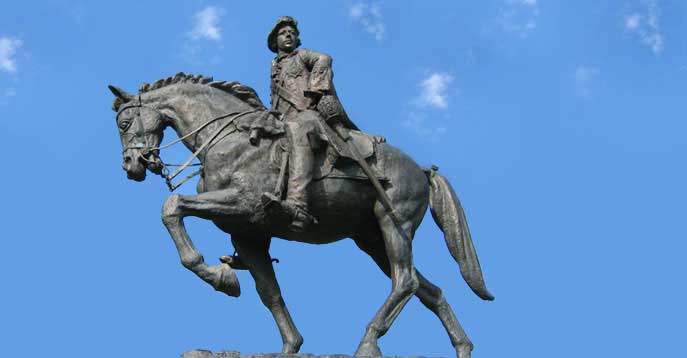 |
| So Wallace died, his bravery and his defiance maintained to the end. His heroism and his total selflessness have earned for him the unforgetting reverence of his people. Only one other Scot has become a national legend, and he - Robert Burns - was moved in all his opinions by the story and the memory of Wallace. 'The story of Wallace,' Burns wrote, 'poured a tide of Scottish prejudice into my veins, which will boil along there till the floodgates of life shut in eternal rest.' Millions of Scots down through the centuries have experienced exactly the same emotion. Scottish resistance after Wallace's defeat did continue and some modest local successes were recorded, but there was no real prospect that the Comyns and Bruce would for long be able to co-operate. John Comyn, head of the family since his father's death in 1303, was Balliol's nephew, his supporter and possibly his successor, assuming that King John would never venture to return from his exile. Bruce on the other hand, was rival to both Balliol and Comyn. The co-operation between them ended with Bruce's resignation of his position as joint Guardian. Comyn and other leaders continued to offer defiance to England, but this resistance crumbled when Edward himself reappeared in Scotland, and compelled the submission of all the Scots leaders in February 1304. Only Stirling Castle held out longer and its Governor, Oliphant, surrendered in July. With these surrenders, and the capture of Wallace in the following year, Scotland once again must have seemed subdued beyond all hope of recovery. What Bruce did during those years remains a matter for controversy. Entering into Edward's peace, he was from time to time shown marks of the English king's approval and favour. Yet, given his pedigree and the ambitions of his family for which he was now responsible, it was unlikely that Bruce any more than Comyn, would accept English conquest and the permanent extinction of the Scottish monarchy. Just what intrigues these men and their various supporters were up to will never be known, but, for whatever purpose, they met by arrangement on 10 February 1306, in Greyfriars Church, Dumfries. The generally accepted view is that they had already been plotting to take joint action against Edward, and that Comyn had, deliberately or otherwise, allowed this to become known. Certainly Bruce had left London in great haste some weeks earlier (warned, according to legend, by the Earl of Gloucester), and he is thought to have come to suspect Comyn of treachery. At all events, the two met and quarrelled, and Bruce stabbed Comyn close by the very altar of the church. The murder was then completed by some of Bruce's associates, and Bruce was now in a desperate position. The murder had turned the political rivalry of two families into a blood feud. The location of the deed made him guilty of sacrilege in the eyes of the Church, from which he was in due course excommunicated. And when people, among them King Edward, began to ask themselves just why the meeting had taken place, and why Bruce had struck down Comyn, they were bound to assume that some sort of conspiracy was afoot. For Bruce to submit to legal process for the murder was inviting the end of all his hopes, and perhaps his life. To attempt to offer any explanation to a suspicious Edward was no more attractive a task. In the circumstances, making the best of a bad job, his wisest course might be openly to claim the crown, and call for support. His first act was to make contact with his old family ally, Bishop Wishart of Glasgow, who proved remarkably unconcerned about sacrilege and perfectly ready to back Bruce in his pursuit of the throne. On Palm Sunday, 27 March 1307, Wishart and Lamberton supervised the crowning of Bruce as King of Scots at Scone by Isabel, Countess of Buchan. Of his adventures thereafter, there is a wealth of information. English and Scottish chronicles give much more information about Bruce than they ever did about Wallace. Bruce had so many advantages that Wallace never could hope for. He was of royal blood, and now king; he had many powerful friends, and he was fighting in his own name to maintain his new dignity. Where the chronicles are silent, the story of Bruce can be picked up in the epic poem The Brus, by John Barbour, who did for Bruce what Blind Harry did for Wallace. |
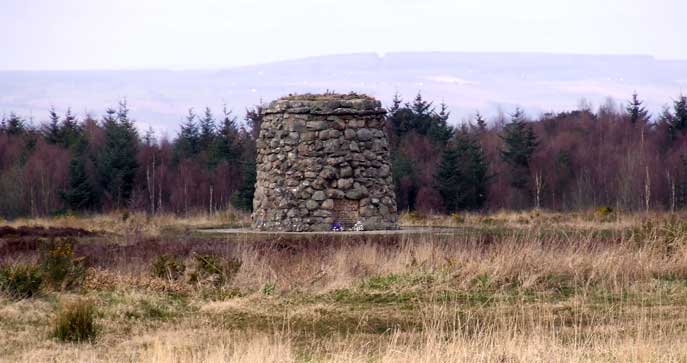 |
From these sources we learn of Bruce's desperate struggle in the early years of his kingship. Surprised and defeated by an English force at Methven in Perthshire in 1307; coming close to death in a skirmish with the Macdougalls of Lorne, relatives and supporters of the Balliol/Comyn cause; a fugitive, reduced to a mere handful of followers, tracked by hunting dogs, and a fugitive again, driven into exile on some remote island, where close to despair, he is reputed to have learned determination from the labours of a spider. But gradually the tide turned, and supporters rallied to him. His best piece of good fortune was the death in 1307 of the great King Edward, who died on the way north yet again to deal with this latest piece of Scottish disobedience. Bruce's supporters proved to be men of some military skill, showing especial talents in capturing castles from their English garrisons. Thomas Randolph captured Edinburgh, after a hair-raising climb up the Castle rock. James Douglas made himself especially feared by the English as he waged ruthless war in his own family lands in the Border country. Even humble men like the Linlithgow farmer, Binning, showed great ingenuity, jamming a cart between the drawbridge and portcullis of Linlithgow Castle, opening the way for Scots to break in and overpower the garrison. The campaign to win back castles went on relentlessly. When a castle was captured it was 'slighted', its foundations undermined and one or more of its walls collapsed. There was no attempt to place Scottish garrisons in the castles. If Bruce had followed that plan he would merely have spread his forces thinly about the country, to be picked off one by one by English counter attacks. The castles were rendered useless, depriving the English of their strong points, their armouries, and their stores. By 1314 only two major castles - Bothwell and Stirling - remained in English hands. Stirling had been besieged by a Scottish force under King Robert's brother Edward. Edward was an impatient soul, who fretted at the long drawn out siege. His patience ebbing fast, he and the English governor, Philip Mowbray, agreed to bring matters to a head by a kind of challenge. Mowbray agreed that if Stirling was not relieved by an English force by midsummer 1314, he would surrender. By this bargain Mowbray left his king, Edward II, no choice but to try to break the Scottish siege; and Edward Bruce left his brother no choice but to confront the English army which must now appear. Such a pitched battle was what King Robert had sought to avoid; the fate of Wallace's army at Falkirk did not encourage any such course of action, but there was no escape now. The English army - greater than any ever before mustered against Scotland - made its way north, starting from its assembly point at Wark on 10 June. By 21 June Edward was in Edinburgh, planning to be in Stirling by 23 June. Bruce had spent the spring and early summer preparing his ground and drilling his men. His army, organised in three divisions with a reserve behind them, lay across the road which led into Stirling from the south. There were no natural obstacles to place between the Scots and charging English cavalry, so artificial obstacles had to be provided. Metal spikes or 'calthrops' which would lame horses, were scattered along the Scottish front; and pits were dug which, it was hoped, would serve as traps for the attackers. By late afternoon on 23 June, the armies were in contact, and it became evident that Edward and his generals intended to waste no time. Sir Henry de Bohun, correctly identifying as King Robert the Scottish officer who was moving back and forth along his lines, decided that matters could be settled quickly, and charged at full gallop upon his intended victim. At the last possible moment Bruce turned his horse aside, and as de Bohun went thundering past, brought his axe down upon the knight's head, leaving him lifeless before the astonished gaze of both armies. First blood to the Scots, but more discouragement awaited the English. An attempt to outflank Randolph's division on the Scots' left was beaten back in a skirmish around St. Ninian's church, and as darkness fell there was doubt and anxiety in the English camp. Edward and his generals had seen fit to move their men to their right, eastward, on to the low-lying ground through which flowed the Bannockburn. The result of this manoeuvre was that Bruce's prepared defences were now useless. The English charge would come not from the south, but from the east. Bruce had to reorganise his men in some haste, and as dawn broke the Scots were ready, looking down the slope at the mighty force which they would shortly have to face. |
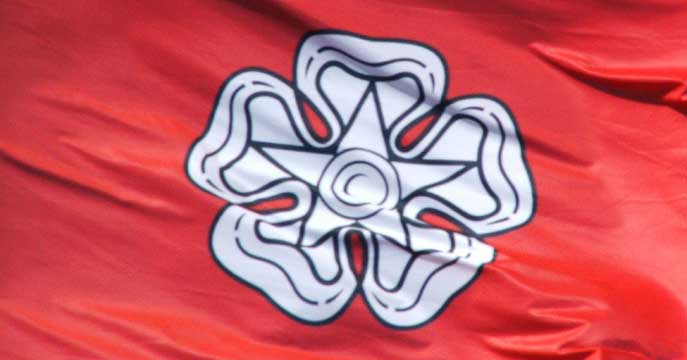 |
At some stage during the night, Bruce had revised his plans. Deprived of his static defences he may have been considering retreat, losing thereby the opportunity of gaining Stirling castle, but saving his army to fight in more favourable surroundings. But there had come to the Scottish camp Sir Alexander Seton, a Scot who had been in the English army, presumably as a Balliol partisan, but who had now either repented, or had detected a change in the winds of war. Seton brought Bruce news of an English army, worried and ill-at-ease, vulnerable to any attack which the Scots might care to mount. It may be that this advice lay behind the decision which Bruce now took. Not only would he fight, but he would not have his men stand passively in their schiltrons to await the English attack. On the contrary, he would take the initiative, and move upon the English who would not be anticipating this mobility from the Scots. |
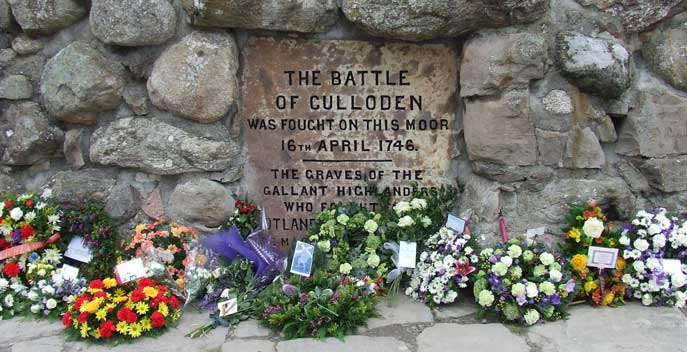 |
The true victor of Bannockburn in a sense, therefore, was the battlefield. Marshes and streams claimed armoured men, unable to rise if they fell. The gorge, we are told, was so filled with the bodies of men and horses that it was possible to walk across it from one bank to the other as though on level ground. From this horror the English army now broke and fled. Edward himself escaped around the Scots' left, and made for Stirling Castle. Mowbray reminded his king that he would be handing the castle over to the Scots in accordance with his bargain with Edward Bruce, and so the hapless king had to circle the battlefield once more, seeking an escape route which would bring him to Dunbar and ships which would take him back to England and safety. |
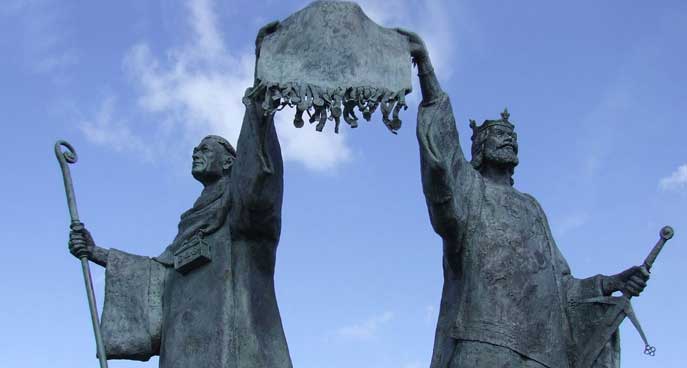 |
| The Scottish church had been steadfastly nationalist all through the years since 1286. Bishops Wishart and Lamberton were proven patriots, but others too deserve to be similarly remembered. Churchmen were after all, the literate class in medieval society, and Scottish churchmen had undertaken the task of expounding and justifying the Scottish case for independence. In 1320, meeting at Arbroath Abbey, the leaders of the community of Scotland put their seals to a document prepared, almost certainly, by Bernard de Linton, abbot and civil servant, which yet again, but more fully now than ever before, spelled out Scotland's claim to identity and independence. Scotland, they reminded Pope John, to whom the Declaration was addressed, had been a kingdom when England was big enough for seven kings. They had endured attack from King Edward who had taken advantage of their misfortunes and had worked to destroy their freedom under guise of friendship. Fate had given them as leader and deliverer, King Robert. Yet - and this is the remarkable passage - 'if he should abandon our cause . . . we should make every endeavour to expel him as our enemy and the subverter of his rights and ours, and choose another for our king.' There are those who look for the origins of monarchy dependent upon popular will, in the writing of seventeenth century English philosophers. Very clearly the Scots had stumbled upon the concept of conditional monarchy several centuries earlier. Finally, in case Pope John or his cardinals thought that Scottish resistance to English ambitions was merely a passing fad, de Linton offered to his countrymen for their approval a pledge of determination free of all ambiguity. 'For so long as a hundred of us shall remain alive we shall never accept subjection to the domination of the English. For we fight not for glory, or riches or honour, but for freedom alone which no good man will consent to lose but with his life.' And yet the Pope remained full of complaint and censure; the English would not concede independence, and the war dragged on. Not until political crisis in England had brought about the deposition and murder of Edward II did the English Parliament weary of paying the bills for endless warfare, and force peace upon their boy King Edward III and his advisers. So, in 1328 the English parliament, meeting at Northampton, agreed to terms of peace. Bruce was at last addressed with all terms of respect due to an independent monarch, and the English claims to overlordship were renounced. Bruce's heir, the four-year-old David, son of King Robert's second marriage, was married to Joan of England, the six-year-old sister of Edward III. It was almost as though the kingdoms were as they had been when King Edward had arranged the future at Birgham. In the years which lay between, Edward had earned and gloried in the title 'Hammer of the Scots', but his hammer blows had moulded and tempered the Scottish nation. The long wars fought to maintain independence had removed, for the moment, any doubt that independence was something to be regarded as normal. |
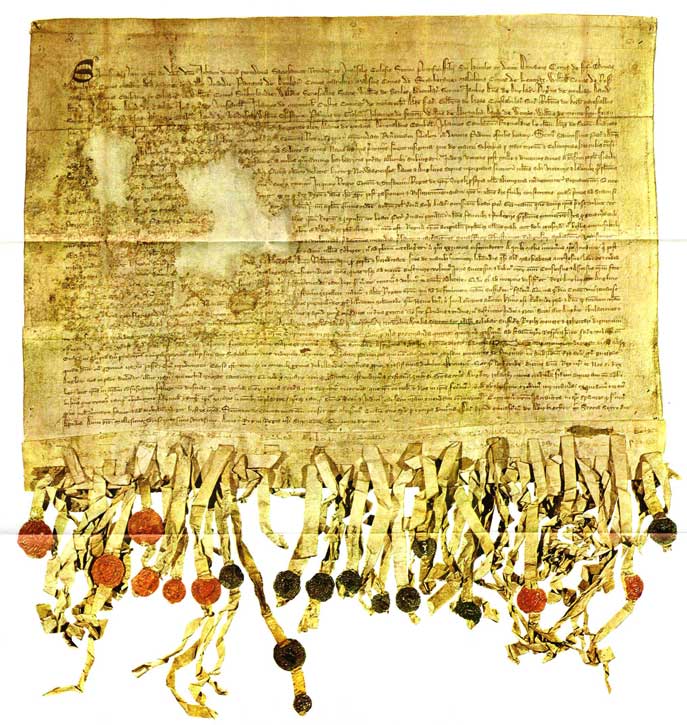 |
Our thanks to ELECTRIC SCOTLAND for this history lesson |
 |
© Paisley Tartan Army 2008-09
